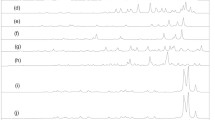Abstract
Boron-based materials have been studied extensively due to their potential applications in hydrogen storage and sensing. Doping their surface with transition metals can improve their electronic properties and chemical reactivity. Here, we have studied the titanium-doped boron cluster containing 38 boron atoms using density functional theory, time-dependent density functional theory (TDDFT) and Bader’s quantum theory of atoms in molecule-based topology analysis. Hexagonal boron rings were found to be suitable for doping. Band gap remains semiconducting in nature. Non-covalent interaction method shows that steric effect is dominant in B38Ti4. Hole–electron distribution analysis of the TDDFT-based absorption spectra shows that peak wavelength redshifts upon doping and that hole is largely situated on boron atoms. Moreover, the excitons are found to tightly bound or Frenkel in nature.







Similar content being viewed by others
References
Chopra S (2019) Mol Phys 117(1):71–78
Chopra S, Plasser F (2017) Mol Phys 115(19):2469–2477
Chopra S (2016) Mater Chem Phys 186:159–166
Chopra S (2016) RSC Adv 6:89934–89939
Chopra S (2015) ChemPhysChem 16(9):1948–1953
Zubarev DYu, Boldyrev AL (2007) J Comput Chem 28:251
Boustani I (1997) Phys Rev B 55:16426
Alexandrova AN, Boldyrev AI, Zhai HJ, Wang LS (2006) Coord Chem Rev 250:2811
Zhai HJ, Kiran B, Li J, Wang LS (2003) Nat Mater 2:827
Lu QL, Luo QQ, Li YD, Huanga SG (2015) Phys Chem Chem Phys 17:20897
Tai TB, Nguyen MT (2015) Chem Commun 51:7677
Sun Q, Wang M, Li Z, Du A, Searles DJ (2014) J Phys Chem C 118:2170
Anota EC, Villanueva MS, Toral DG, Carrillo LT, Martínez MRM (2016) Superlattice Microstruct 89:319–328
Anota EC, Morales AE, Cocoletzi HH, López JGL (2015) Physica E 74:538–543
Batista RJC (2010) Chem Phys Lett 488:209
Mahdavifar Z, Poulad M (2014) Sens Actuators B Chem. 205:26
Wang W, Zhang X, Li P, Sun Q, Li Z, Ren C, Guo C (2015) J Phys Chem A 119:796
Bahrami A, Yourdkhani S, Esrafili MD, Hadipour NL (2014) Sens Actuators B Chem 191:457
Jin P, Hou Q, Tang C, Chen Z (2015) Theor Chem Acc 134:13
Zhai HJ, Zhao YF, Li WL, Chen Q, Bai H, Hu HS, Piazza ZA, Tian WJ, Lu HG, Wu YB, Mu YW, Wei GF, Liu ZP, Li J, Li SD, Wang LS (2014) Nat Chem 6:727
Yan QB, Sheng XL, Zheng QR, Zhang LZ, Su G (2008) Phys Rev B 78:201401
Wang L, Zhao J, Li F, Chen Z (2010) Chem Phys Lett 501:16–19
Lv J, Wang Y, Zhua L, Ma Y (2014) Nanoscale 6:11692
He R, Zeng XC (2015) Chem Commun 51:3185
Koponen L, Tunturivuori L, Puska MJ, Nieminen RM (2007) J Chem Phys 126:214306
Li S, Zhang Z, Long Z, Qin S (2017) Sci Rep 7:40081
Chopra S (2018) J Mol Graph Model 84:90–95
Dong HD, Hou T, Lee ST, Li Y (2015) Sci Rep 5:9952
Jin CP, Liu C, Li Y, Li L, Zhao Y (2018) Int J Quantum Chem 118:e25501
Liu P, Zhang H, Cheng X, Tang Y (2016) Int J Hydrogen Energy 41(42):19123–19128
Granovsky AA. Firefly version 8.1.0. http://classic.chem.msu.su/gran/firefly/index.html
Adamo C, Barone V (1999) J Chem Phys 110:6158–6169
Grimme S, Antony J, Ehrlich S, Krieg H (2010) J Chem Phys 132:154104
Grimme S, Ehrlich S, Goerigk L (2011) J Comput Chem 32:1456
Lu T, Chen FW (2012) Multiwfn: a multifunctional wavefunction analyzer. J Comput Chem 33:580–592
Noorizadeh S, Shakerzadeh E (2010) Phys Chem Chem Phys 12:4742
Morell C, Grand A, Toro-Labbé A (2005) J Phys Chem A 109(1):205–212
Fu R, Lu T, Chen F-W (2014) Acta Phys Chim Sin 30(4):628–639
Johnson ER, Keinan S, Sánchez PM, García JC, Cohen AJ, Yang W (2010) J Am Chem Soc 132:6498
Kittel C (2005) Introduction to solid state physics. Wiley, Hoboken
Lu T, Chen F (2012) J Theor Comput Chem 11:163
Kraner S, Prampolini G, Cuniberti G (2017) J Phys Chem C 121(32):17088–17095
Author information
Authors and Affiliations
Corresponding author
Ethics declarations
Conflict of interest
The authors report no conflicts of interest in the publication of this work.
Additional information
Publisher's Note
Springer Nature remains neutral with regard to jurisdictional claims in published maps and institutional affiliations.
Electronic supplementary material
Below is the link to the electronic supplementary material.
Rights and permissions
About this article
Cite this article
Chopra, S., Lu, T. A DFT/TDDFT and QTAIM based investigation of the titanium-doped Boron-38 cluster. Theor Chem Acc 139, 136 (2020). https://doi.org/10.1007/s00214-020-02647-3
Received:
Accepted:
Published:
DOI: https://doi.org/10.1007/s00214-020-02647-3




